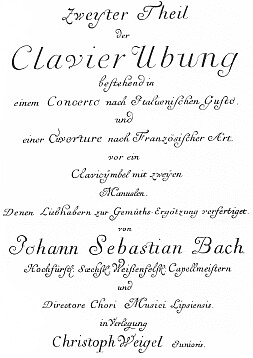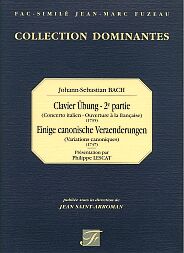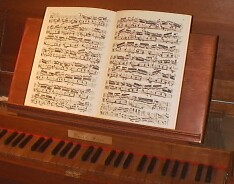Bach's Clavier-Übungen
in facsimiles
Part Two
Italian Concerto (BWV 971)
and
French Overture (BWV 831)
1735
Original size of plate: c.31.5 x 21 cm
Original size of paper: c.34.5 x 25 cm
|
 |
|
FRONT COVER
|
OVERVIEW
|
 Dimension: 33 x 24 cm
Dimension: 33 x 24 cm
|
| TITLE |
Johann-Sebastian Bach: Clavier-Übung. (2e partie
- Concerto italien - Ouverture à la française). (1735). Einige
canonische Veraenderungen (Variations canoniques). (1747). Présentation
par Philippe Lescat. Fac-similé Jean-Marc Fuzeau: Collection Dominantes.
No. 3286 |
| PUBL. DETAILS |
Courlay: Editions J. M. Fuzeau (1992, 2/1998), 33p text,
27p facs (CU2); 6p facs (Canonic Variations); paper back. Price: Fr.F 138,00;
Euro 19,94. |
| ISBN |
n/a |
| TO ORDER |
J.M.Fuzeau,
Boîte Postale 6, 79440 Courlay, France. Email:
facsimiles@fuzeau.com |
|
SUMMARY
|
| DESCRIPTION |
Facsimile of Bach's Handexemplar of CU2 (GB-Lbl/K.8.g.7)
+ Canonic Variations (F-Pn/Rés F1104) in high-quality paper / print
/ binding; can be used for performance purposes. |
| READERSHIP |
Scholars and music students who need to study Bach's
original prints. |
|
The Second Part of the Clavier-Übung
was
published in 1735. It consists of the Concerto after the Italian Taste
(BWV 971) and the Overture in the French Style (BWV 831), which
effectively deal with two of the most topical orchestral genres of his
time, each representing the most important national styles of the day,
i.e. Italian and French. In transcribing them for a two-manual harpsichord,
Bach explores contrast at many different levels, e.g. styles, keys, textures,
rhythms, tempo and dynamics.
The work must have caught public attention very quickly, for the second
edition appeared in a year’s time. It was highly praised by Johann Adolph
Scheibe in 1739, who earlier criticised the style of Bach’s writing as
‘turged and confused’; his review of the Italian Concerto runs as follows:
… But preeminent among published musical works is a clavier
concerto of which the author is the famous Bach in Leipzig and which is
in the key of F major. Since this piece is arranged in the best possible
fashion for this kind of work, I believe that it will doubtless be familiar
to all great composers and experienced clavier players, as well as to amateurs
of the clavier and music in general. Who is there who will not admit at
once that this clavier concerto is to be regarded as a perfect model of
a well-designed solo concerto?
As regards Bach’s manuscripts, there survives no autograph of the work
that transmits the definitive version. There are several manuscripts that
transmit an early version of the work, which, when compared with the published
editions, tells us some interesting aspects of the works’ development.
The interested readers may consult the following articles published recently:
Italian Concerto: Kirsten Beißwenger, ‘An early
version of the first movement of the Italian Concerto BWV 971 from the
Scholtz Collection?’, Bach Studies 2, edited by Daniel R. Melamed
(Cambridge, 1995), pp. 1–19.
French Overture: Ido Abravaya, ‘A French overture revisited:
another look at the two versions of BWV 831’, Early Music, 25/1
(1997), pp. 47–61; see also Matthew Dirst’s article ‘Bach’s French overtures
and the politics of overdotting’ in the same journal, pp. 35–44.
The printed edition was published by the Nuremberg publisher Christoph
Weigel (1703–1777), but he closely worked with several others, including
Balthasar Schmid who engraved the title-page shown above. Their names are
disclosed only recently by Gregory Butler. For further details, see his
article ‘The Engravers of Bach's Clavier-Übung II’, A Bach Tribute:
Essays in Honor of William H. Scheide, ed. by Paul Brainard and Ray
Robinson (Kassel: Bärenreiter, 1993), pp. 57–69. |


Engraved by J. G. Puschner (above)
and J. C. Döhne (below)
|
Probably because the engraving was carried out in Nuremberg, Bach was unable
to check the proof, and hence there are numerous engraving errors in the
first edition (5 copies are known to have survived). The second edition
(11 copies are known to have survived) not only corrects many of these
errors (on the same plates), but also improving the pagination of Gavotte
II in the French Overture by re-engraving pages 20–22, so that one can
play the movement without a page turn. For some reason, this new edition
does not incorporate all the corrections that Bach made to the copies of
the first edition he possessed.
Bach’s corrections on his editions give insight into the way he assessed
his own work critically; there are many interesting details that we can
learn from these, especially lots of extra ornaments that he felt necessary.
Knowing what Bach considered important at the time of revisiting his own
works brings to our mind a strong feeling of ‘authenticity’; when carefully
analysed in the context, one can also learn from these changes much inspiration
about Bach’s compositional thinking, effective articulation and ornamentation
in actual performance. If you want to pursue this idea, you can find all
essential information in the Kritischer Bericht V/2 (1981) of the
Neue
Bach Ausgabe edited by Walter Emery and Christoph Wolff.
The facsimile edition reviewed here is probably the only one that is
available today. There are other editions published in 1980–90s, such as
Gregg (1985), Edition Peters (1984), and Performer’s Facsimile (1990),
but these were not made available for my review and I cannot therefore
comment at present.
| The Fuzeau edition is a reproduction
of the first edition in the British Library, London (K.8.g.7). This copy
is currently considered as the most important, for it appears to be the
copy that Bach kept for his own revision purpose (= Handexemplar).
The facsimile edition is designed for practical use; it gives perfectly
legible text. In fact, the print image is enlarged for better legibility.
Using thick, high-quality paper and strong but flexible binding, it sits
well on the music stand on my clavichord (see the picture on the right).
It also includes a very helpful introduction in French, English and German,
covering some of the historical background of this work and the list of
Bach’s hand-written corrections in this copy.
Musicologists may find its clear and high-contrast, single-colour ink
reproduction slightly problematic, as it does not help to distinguish Bach’s
later additions from the printed symbols, though the information is provided
in the introduction. |
 Fuzeau edition and my Clavichord
Fuzeau edition and my Clavichord
|
Published on-line on 24 May 2000


